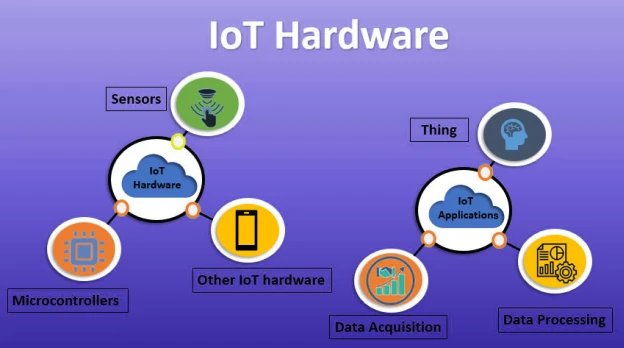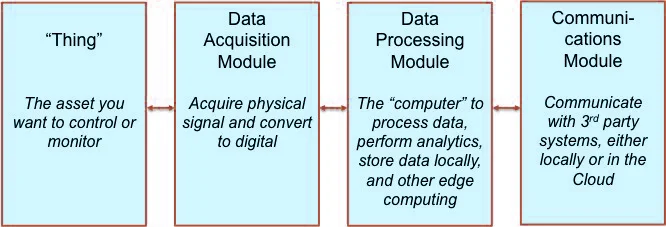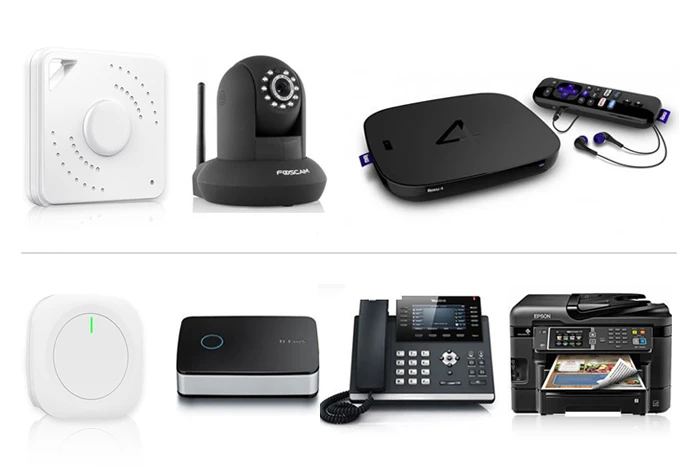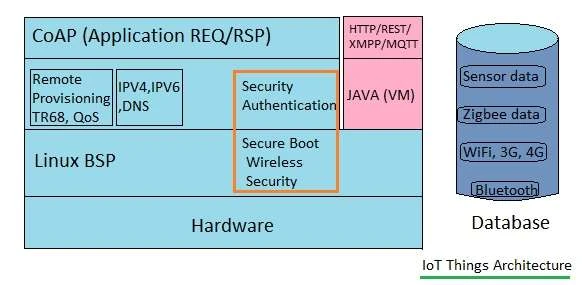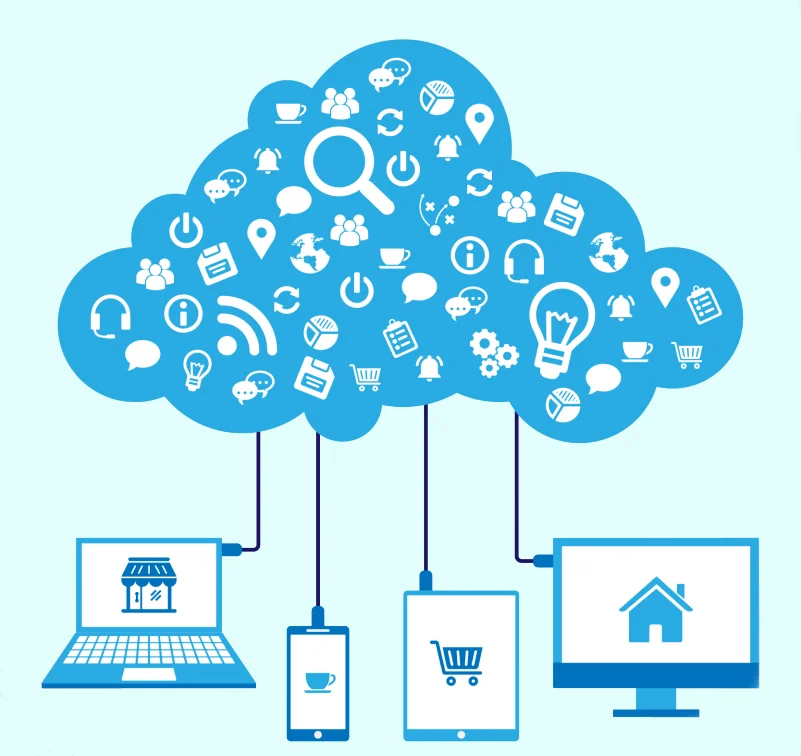IoT Hardware constitutes a wide variety of devices like sensors, bridges, and routing devices. These IoT devices perform critical functions of managing essential tasks such as activating the system, communication, action stipulations, security, and detecting detailed actions and goals. Below, you will learn the IoT hardware devices available at MOKOSmart that uses the IoT technology, the IoT hardware building blocks, the architecture of IoT software, and the common IoT hardware platforms. Moreover, we will discuss the essential IoT hardware requirements needed to deploy an IoT project and all about microcontroller development boards, single board computers, and processors.
The IoT hardware building blocks
In this section, we will discuss some building blocks of IoT hardware.
Thing
In IoT, “Thing” represents the asset intended to measure, monitor, or control. Most IoT products fully incorporate their smart devices with the “thing.” For instance, products such as automatic vehicles and smart refrigerators thoroughly monitor and control themselves.
In some other applications where “the thing” is used as an alone device, a particular product must be linked to certify that it holds smart capabilities.
Data Acquisition Module
This IoT hardware component focuses on obtaining physical signals from the monitored or observed thing. It later converts them to digital signals that a computer can easily interpret or manipulate. All sensors that assist in attaining real-world signals like pressure, density, temperature, light, vibration, and motion are contained in this IoT hardware component. The application determines the number and type of sensors needed.
Also, the data acquisition module comprises the required hardware that is essential for converting signals from the incoming sensor to digital data used by the computer. This involves incoming signal habituation, interpretation, analogue-to-digital conversion, scaling, and minimizing noise.
Data Processing Module
It comprises the critical unit used to process data that executes operations like local data storage, local analytics, and other computing operations.
Communication Module
This module allows effective communication between the Cloud Platform and 3rd party systems either in the cloud or locally.
IoT Hardware Sensors
Sensors are the most critical item in IoT hardware. IoT sensors comprise multiple modules like power management modules, RF modules, sensing modules, and energy modules. They are ideal for application in;
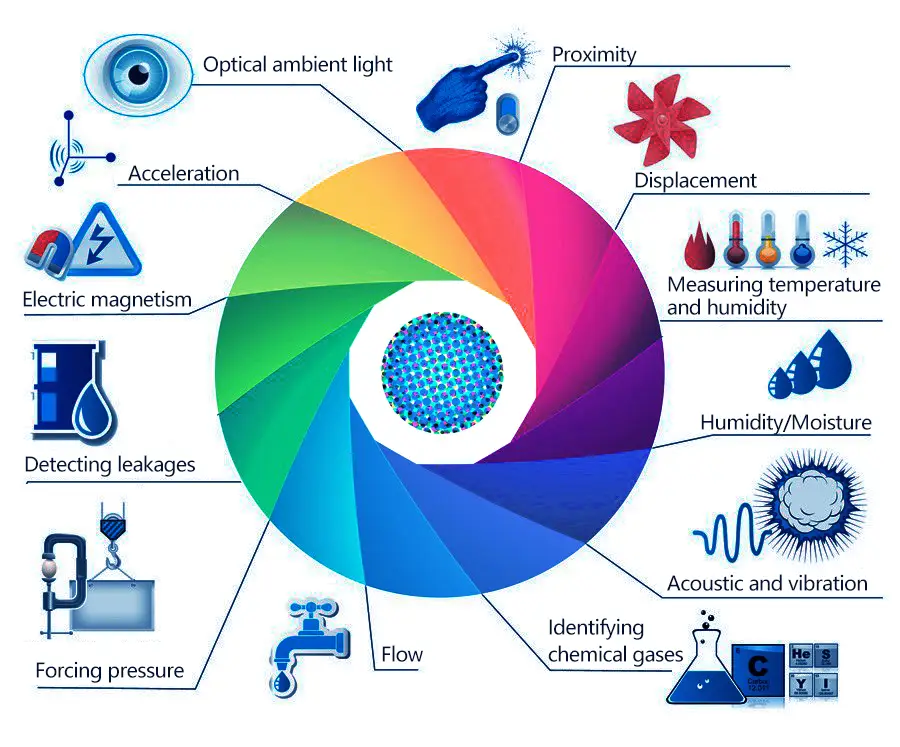
- Proximity
- Optical ambient light
- Detecting leakages
- Measuring temperature and humidity
- Electric magnetism
- Acceleration
- Acoustic and vibration
- Identifying chemical gases
- Displacement
- Forcing pressure
Sensors
IoT data cannot exist without sensors. All IoT sensors create analogue electric signals which are proportionate to a physical asset. Sensors use ADCs (Analog-to-Digital Converters) to convert these analogue signals to digital data. Also, simple electrical properties like current, inductance, voltage, resistance, and impedance can be measured using sensors.
Moreover, the direction and strength of magnetic and electric fields can be measured using sensors.
Non-electric properties that are measured by sensors use a transducer to change physical properties to analogue electrical signals.
The most common physical properties are;
- 3-D parameters like velocity, acceleration, displacement, and vibration.
- Ecological properties like humidity and temperature.
- Liquid fluid dynamics like pressure, flow rates, and sound.
Wearable Electronic Devices
These are small pieces of equipment worn on the head, arms, neck, feet, and torso. Some of the wearable electronic devices currently available in the market include;
- Smart glasses that are worn in the head
- Collars that are worn on the neck
- Smart watches that are worn on the arm
Backpacks and some other clothing pieces are worn on the torso
Other IoT Hardware Devices
We use devices every day, like tablets, mobile phones, and desktops, as essential parts of an IoT system. Mobile phones allow functional remote and other integral modification settings. The desktop enables the user to control the system thoroughly.
While tablets enable users to access the system’s key features and are also used as remote, standardized network devices such as switches and routers form other key connected devices.
Characteristics of IoT Hardware device
With the rapid introduction of new industrial IoT hardware platforms, its landscape has developed constantly. IoT devices have common key characteristics that offer evaluation when picking hardware and software used in configuring a new IoT network or expanding and developing the already prevailing networks. Essential capabilities that are characterized by IoT devices are;
Connectivity
All IoT devices have network connectivity as their defining characteristic. When IoT devices locally communicate with others, they use cloud-based services to publish data. Most IoT devices transfer information wirelessly, either using Bluetooth beacon, 802.11 (Wi-Fi), cellular networks, RFID, or the LPWAN technologies such as SigFox, LoRa, or NB-IoT. All immobile devices are equipped with a wired communication system. These stationary devices are either installed in industrial control applications, home automation, and smart buildings. Standard protocols like the Controller Area Network (CAN) or the Universal Asynchronous Receiver Transmitter (UART) connect devices as a form of serial communication.
Power management
Portable and wearable devices that heavily rely on wireless power sources such as photovoltaic cells and batteries consider power management a hazardous factor. Most users sometimes put their devices into low power mode or into sleeping mode to preserve power. This depends on the user’s usage patterns and the power necessities of the involved integrated circuits (ICs), sensors, or actuators. The device’s rate of power consumption rises as you increase the attached components.
Microcontroller development boards
A microcontroller is a form of SoC that processes data and can store vast amounts of data. They comprise memory, processor cores, and an erasable programmable read-only memory (EPROM) used to keep all custom programs running on the microcontroller. Moreover, microcontroller development boards have an extra electrical structure for supporting the microcontroller making it more beneficial in programming or prototyping with the chip.
The microcontroller is connected with actuators and sensors via a hardware bus or analogue or digital General-Purpose Input/Output (GPIO) pins. All components connected to the bus using standard communication protocols such as SPI and I2C, and SPI to communicate. Swapping or adding elements linked with the bus are made more accessible when the user adopts some set standards.
Single-board computers (SBCs)
They are more improvised than microcontrollers. Single-board computers enable the user to join in peripheral devices such as screens, keyboards, the mouse. It, on top, offers more power needed for processing and more memory. For instance, a microcontroller has an 8-bit 16KHZ microprocessor, while the single board computers have a 1.2 GHz 32-bit ARM microprocessor.
Which is the best to choose between microcontroller development boards and single-board computers?
When planning to purchase either a microcontroller development board or a single board computer, it is essential to contemplate the main characteristics of the device concerning the requirements of your application. Also, use the following decisions to work through;
- Establish the quantity and sort of output components and peripheral sensors essential for the component’s design circuits if necessary.
- Choose a single board or a microcontroller to control and coordinate the components of a peripheral system.
- Pick the essential protocols of data communication protocols that you may require for intra-device communication use. For instance, to communicate between a microcontroller and attached sensors, use an I2C.
- Determine the protocols and networking hardware essential to communicate with applications and cloud services.
- Compare the design intent you anticipate achieving after you advance further with your IoT landscape design.
- Access the embedded software, prototype, device design and select the best applications and services. It is possible from time to time to evaluate your prototypes alongside your functional and non-functional requirements, such as security, performance, and reliability. Then revisit the choices you feel are necessary.
IoT hardware requirements for deploying your IoT project
IoT devices operate only within some set environs, and their hardware projects differ widely; hence, they are highly specialized. Nevertheless, it is possible to develop and design your custom PCBs and their components custom-made for the requirements of your IoT solution by prototyping with the generic off-the-shelf hardware. When deploying your IoT project, it is essential to consider the below IoT hardware requirements:
Security requirements
Security is an essential component of the Internet of Things. Considering the device’s security requirements is imperative at all the development and designing stages. Even when prototyping, make sure the security and integrity of data captured by any device remain intact. All IoT devices, their network, service applications of websites, and mobiles apply the security requirements.
Ease of development
Ease of development is a requirement of high priority when prototyping. It enables the user to get the IoT device up and running quickly and efficiently when capturing data and interconnecting with other devices and the cloud. When deploying your IoT projects, have in mind the API documentation’s quality, accessibility, and availability. Also, consider the tools of development, and support provided by the device’s manufacturer or by the development team.
Data acquisition, processing, and storage requirements
The number of sensors connected to the captured data’s resolution and the sampling rate are the main determinants of the data’s volume to be processed. They also influence the requirements of storing and processing data.
Connectivity requirements
Wireless networking has connectivity requirements such as operating range, distance covered by the transmitting signal, and the predicted data and transmitted volume. When checking on the device’s connectivity requirements, it is vital to contemplate the fault tolerance, the device’s reconnecting capability, and how long a device takes when retrying to send data after it disconnects.
Power requirements
The power requirements are impacted mainly by the network transmission rate and the number of sensors in the device. Therefore, when deploying your IoT project, it is essential to consider if the device needs a mobile power source such as a super capacitor or a battery or hardwired for power. Also, know the battery’s size, capacity requirements, weight, and if the battery is recharged, replaced, or discarded when it dies. In case the battery is rechargeable, check by what means and how often it is charged?
Physical device design requirements
They include the size and physical appearance of the hardware device. When designing an IoT device, it is essential to consider the ecological situations in which the device will be installed. For instance, consider if the device will require a ruggedized or a waterproof? All appliances installed on a truck’s underside as part of a fleet monitoring application should always be safeguarded to ensure that it works well, even when under harsh conditions. The device has to be water-resistant and impervious to shock, dirt, and vibration.
Cost requirements
The original hardware’s outlay and allied components like sensors are the main determinants of the hardware’s price. Other components that determine the hardware cost include the ongoing operating cost like the maintenance and power cost. Also, it is essential to think through the reasonable licensing fees for some device’s drives and components. Assembling custom boards is more expensive than purchasing commercially accessible off-the-shelf development boards. It is a wiser alternative to consecrate hardware devices when scaling out in the IoT network with numerous instruments.
Processors
Data is processed once the sensor data capture it before conveying the outcomes to the cloud. Thus, the quantity of data processing needed to create the subsequent sensor data and the complexity of sensors determines the processing level. For example, the temperature reading is a simple illustration of an average of set values or a single data value over time. Moreover, a security camera unable to record digital video without the scene detection algorithm flagging an event can be more complex.
Based on the complexity and power needed to process data, four IoT hardware processing classes are required. They are;
PC Based Systems
The PC-based systems are configurable platforms that allow easy creation of custom systems by system integrators from cheap, typical processors, off-the-shelf motherboards, cases, and power supplies. Extensive local data storage capabilities are provided mainly by Solid-state drives (SSDs) or terabyte hard drives.
Mobile Systems
Mobile systems incorporate embedded systems that have a specialized subset optimized for smartphones and tablets. All mobile systems require frequent charging as the devices are battery-powered. These intrinsically personal devices have advanced power management system capabilities to conserve energy and extend the device’s battery life. Also, mobile systems offer processing capabilities of high-performance.
Microprocessor (MPU) Based Embedded Systems
They offer an inclusive options range of capability and performance elevated to address requirements for specific products. The requirements are primarily for communication systems, consumer electronics, automotive and industrial controls, medical devices, and other vertical market applications.
Microcontroller (MCU) Based Embedded Systems
These systems require minimal processing necessities, and they offer solutions of low-cost. Nevertheless, microcontrollers are advanced implant-specific hardware modules to speed up the processing of images and security roles like cryptographic acceleration for exchanging public/private keys and True Random Number Generation (TRNG).
IoT Hardware Architecture
Micro-controller units can be used to construct the IoT device hardware architecture. The system’s chip resources, interfaces, and power determines the choice of a micro-controller unit. Some features have to be collected to settle the IoT hardware design. These features assist in finalizing the perfect IoT hardware prototype and the price of the obligatory IoT hardware kit. They include;
- Type of actuators or sensors
- Type of communication interface
- Quantity of captured and transmitted data
- Data transportation frequency
IoT Software Architecture
The open-source components are the basis of the IoT software architecture. The figure above portrays how the IoT architecture is commonly used in most systems. Linux doesn’t need to settle on the target IoT hardware and software development; hence it is more widely used.
Currently, most companies aim to provide IoT frameworks ready to use in countless IoT detailed applications. The CoAP protocol is mainly used as it is exclusive to applications of the IoT. The protocol also provides a standard mechanism that links with IoT devices.
Common IoT Hardware Platforms
The essential components in Internet of Things applications are the IoT hardware platforms. These devices can quickly help you to build your DIY prototype or project. Some of the most common hardware platforms used in IoT developments are;
- Raspberry Pi – Raspberry Pi is extensively widespread as a small, cheap computing board amongst technology fanatics, experimenters, and educators.
- Arduino (Genuino) – It is an open-source prototyping platform based on software and hardware that are easy to use.
- ESP8266 – It joins a 160 MHz microcontroller with access and client points full TCP/IP stacks and Wi-Fi front-end with DNS.
- Intel Edison – This small development platform features a 32 bytes Intel Quark microcontroller with an Intel Atom CPU.
- Intel Galileo – This Intel-based architectural AWS IoT hardware platform is a software package and computer hardware pin-compatible with shields of Arduino intended for the Uno R3.
- BeagleBone – This open-hardware is easy to assemble as it is a small open-software computer that is pluggable into all sorts of items available at home.
- Banana Pi – It is a single-board computer that aims to be tiny, cheap, and flexible enough for everyday usage.
- NodeMCU Dev Kit – It all in one board integrates the PWM, ADC, 1-Wire, GPIO, and IIC as it is based on the ESP8266 Wi-Fi chip.
- Flutter – Flutter has a high-speed ARM processor, an IoT hardware security chip onboard, in-built charging batteries, and solid long-range wireless communication.
Open source is pervasive in IoT hardware
Most IoT developers are familiar with the use of open-source where more than 91% of them apply the open-source software, open data, or open hardware in more than one fragment of their development stack, making it more persuasive. However, less than 2 out of 10 IoT developers mostly rely on the patented technology, and it is less likely for them to adapt the open-source option. IoT open-source hardware usage is dominant amongst most IoT hardware companies. This high use rate always maintains irrespective of the developer’s motive, whether for learning, fun, or money.
Open source is the new standardization
Using standard solutions has the same productivity gains as those provided by using open standards. In addition, applications of public standards in open sources assist in solving interoperability challenges, which is a critical problem in the emerging Internet of Things. It is crucial always to contemplate the abridged training expenses of new personnel acquainted with the open-source technology you use. This is what Google did when subcontracting its MapReduce technology. Mainly, open-source solutions are used in the Azure IoT hardware space.
Open source attracts developers
Open source has an immense enthusiasm among developers as they are more subtle to the proposition values and standards offered by the open-source. More than 78% of IoT developers prefer using the open-source technology in at least one development field whenever they can than in alternatives that are superior to proprietary. When a company operates and endorses an open-source, they signal a top-notch technology to the developer in three vital aspects.
- Bringing into line with the developer’s ethos and ethics
- Highpoints your solution value and developer’s support
- Shades the technology as leading-edge
